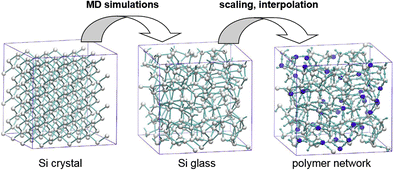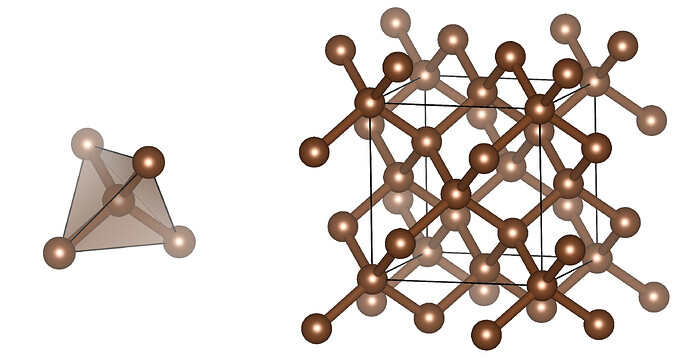I'm Praveen Kumar, a research scholar in the chemistry department.
Actually, I'm new in this field and presently using a simulation package
(LAMMPS). I want to know, How can write a lammps script for the diamond
network.
or Can anyone share your lammps script or whatever use to create this
diamond network or any suggestion? Please Help me.
Thank you.
There are multiple examples in $LAMMPS/examples directory. One that builds a diamond cubic Si is comb/in.comb.Si.
Ray
There are multiple examples in $LAMMPS/examples directory. One that
builds a diamond cubic Si is comb/in.comb.Si.Ray
I'm Praveen Kumar, a research scholar in the chemistry department.
Actually, I'm new in this field and presently using a simulation
package
(LAMMPS). I want to know, How can write a lammps script for the
diamond
network.
or Can anyone share your lammps script or whatever use to create this
diamond network or any suggestion? Please Help me.
Thank you.------------------------------------------------------------------------------
Check out the vibrant tech community on one of the world's most
engaging tech sites, Slashdot.org! http://sdm.link/slashdot
_______________________________________________
lammps-users mailing list
[email protected]
https://lists.sourceforge.net/lists/listinfo/lammps-usersThank you so much to reply. Actually, I want polymer Network like
diamond (bead-spring model). Please find attachment (Like This)

From your figure, it seems like you want to build a system resembling a diamond crystal where the “bonds” between the atoms in the diamond lattice have been replaced by polymers. I guess the blue and white dots in your figure represent a junction where 3 polymers come together. Is this correct? If so, this is not the easiest system to build.
It’s easy to build a periodic crystall, either in LAMMPS itself, or using tools like moltemplate or topotools. Each unit cell can contain covalent bonds. However problems can arise if there are bonds crossing the unit cell.
I believe topotools can mostly solve this problem by automatically connecting nearby atoms with bonds, however last I heard it does not yet know how to do this accross the simulation boundaries. So if you have an infinite periodic lattice, you will have to add bonds connecting polymers which cross the periodic boundary manually.
Moltemplate can easily build a lattice containing molecules, however each bond must be listed explicitly. Moltemplate does not know how to automatically connect nearby atoms. (You can add these bonds in moltemplate, but you have to list those bonds manually using a write(“Data Bonds”) command ) Alternatively, if you can generate a list of bonds as well as their starting and ending points, I can show you how to turn each bond into a separate polymer in one line using moltemplate’s “new” and “rotvv” commands. This might save you some effort, but you will still have to join these polymers together at the junction points manually.
I’m not familiar enough with the other builder tools to comment on them. If someone else has an easier way, please post.
Andrew
From your figure, it seems like you want to build a system resembling a
diamond crystal where the "bonds" between the atoms in the diamond lattice
have been replaced by polymers. I guess the blue and white dots in your
figure represent a junction where 3 polymers come together. Is this
correct? If so, this is not the easiest system to build.It's easy to build a periodic crystall, either in LAMMPS itself, or using
tools like moltemplate or topotools. Each unit cell can contain covalent
bonds. However problems can arise if there are bonds crossing the unit
cell.
I believe topotools can mostly solve this problem by automatically
connecting nearby atoms with bonds, however last I heard it does not yet
know how to do this accross the simulation boundaries. So if you have an
infinite periodic lattice, you will have to add bonds connecting polymers
which cross the periodic boundary manually.
Moltemplate can easily build a lattice containing molecules, however
each bond must be listed explicitly. Moltemplate does not know how to
automatically connect nearby atoms. (You can add these bonds in
moltemplate, but you have to list those bonds manually using a write("Data
Bonds") command ) Alternatively, if you can generate a list of bonds as
well as their starting and ending points, I can show you how to turn each
bond into a separate polymer in one line using moltemplate's "new" and
"rotvv" commands. This might save you some effort, but you will still
have
to join these polymers together at the junction points manually.I'm not familiar enough with the other builder tools to comment on
them. If someone else has an easier way, please post.Andrew
> There are multiple examples in $LAMMPS/examples directory. One that
> builds a diamond cubic Si is comb/in.comb.Si.
>
> Ray
>
>
> On 8/27/18, 9:42 PM, "Praveen Kumar" <[email protected]...>
wrote:
>
> I'm Praveen Kumar, a research scholar in the chemistry department.
> Actually, I'm new in this field and presently using a simulation
> package
> (LAMMPS). I want to know, How can write a lammps script for the
> diamond
> network.
> or Can anyone share your lammps script or whatever use to create
this
> diamond network or any suggestion? Please Help me.
> Thank you.
>
>
>
>
------------------------------------------------------------------------------
> Check out the vibrant tech community on one of the world's most
> engaging tech sites, Slashdot.org! http://sdm.link/slashdot
> _______________________________________________
> lammps-users mailing list
> [email protected]
> https://lists.sourceforge.net/lists/listinfo/lammps-users
>
>
> Thank you so much to reply. Actually, I want polymer Network like
diamond (bead-spring model). Please find attachment (Like This)------------------------------------------------------------------------------
Check out the vibrant tech community on one of the world's most
engaging tech sites, Slashdot.org! http://sdm.link/slashdot
_______________________________________________
lammps-users mailing list
[email protected]
https://lists.sourceforge.net/lists/listinfo/lammps-usersThank you lammps-uers,
Yeah, I make understand. In diamond network, each lattice point consider
as a bead and these beads are connected through harmonic spring (like
harmonic bead-spring model). In this network each bead connected to other
nearest four beads (like in diamond each diagonally bead connected by 3
face beads and 1 corner bead). And I want repeating units of this network.
Please have a look attached structure. I would like to thanks in advance.
if get .data file of this network.
[…]
Yeah, I make understand. In diamond network, each lattice point consider
as a bead and these beads are connected through harmonic spring (like
harmonic bead-spring model). In this network each bead connected to other
nearest four beads (like in diamond each diagonally bead connected by 3
face beads and 1 corner bead). And I want repeating units of this network.
ray already gave you a suggestion how to generate atoms on the lattice positions of a diamond crystal with LAMMPS and steve already suggested how you can add bonds to such a system with LAMMPS. have you tried these out?
Please have a look attached structure. I would like to thanks in advance.
if get .data file of this network.
please realize, that it is your task to apply available tools to build the structure you need. it is not the task of the mailing list, to do that work for you. people here volunteer their time, they can point you into the right direction (or a different one, in case others didn’t work out), but nobody has the time to figure out a complete solution for you. most problems cannot be solve with a simple “do this, not that” kind of solution, but you will have to solve them in steps, possibly using multiple commands and/or tools.
axel.
